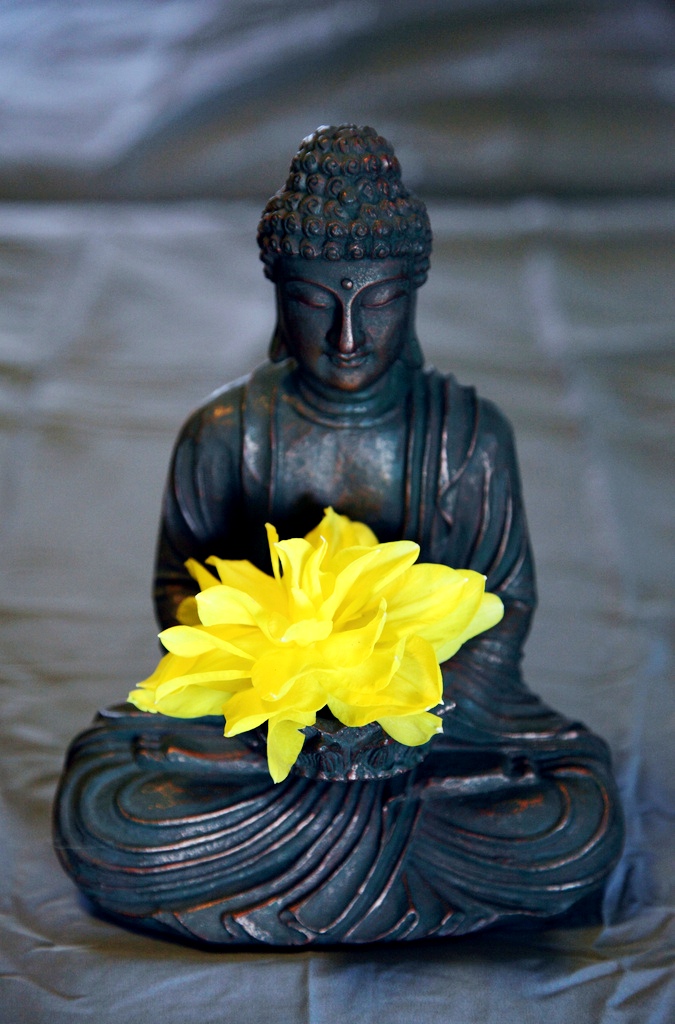NĂM CÁCH SỐNG HẠNH PHÚC HƠN
THEO PHẬT GIÁO
Francesca Biller
Diệu Liên Lý Thu Linh chuyển ngữ
Một giáo lý căn bản của Phật giáo dạy rằng hạnh phúc hay khổ đau là trách nhiệm của từng cá nhân. Điều đó có nghĩa là tất cả chúng ta đều hoàn toàn làm chủ việc chuyển đổi cuộc sống của chúng ta. Thật là một tư duy mới mẻ, tràn đầy giác ngộ! Tôi tin rằng những bài học về cuộc đời mà tôi đã học được từ Phật giáo sẽ tiếp tục truyền sức sống và ban trải sức mạnh, uy lực thực sự của chúng cho tôi khi tôi đối mặt với những nỗi sợ hải, thách thức và những cuộc chiến đấu với đau khổ mà giờ tôi mới biết rằng chúng chỉ là một phần trong kinh nghiệm sống của một kiếp người. Tôi hy vọng là năm khía cạnh của trí tuệ Phật giáo dưới đây sẽ giúp bạn được an lành.
1. Thiền
♦ Bắt đầu như thế nào
2. Bắt đầu Mỗi Ngày Với một Ðộng Lực Tích Cực
– Tôi sẽ giữ sự giác ngộ tích cực suốt ngày và luôn học hỏi từ người khác.
– Tôi sẽ xem mọi người đều dễ thương, hiền lành và cởi mở như tôi, và tôi sẽ không phán xét người.
3. Thực hành Chánh niệm
4. Phương cách Thực hành Chánh niệm
Bắt đầu bằng cách ý thức hơn về các cảm xúc của mình khi chúng khởi lên, dầu đó là cảm thọ vui, đau đớn, hưng phấn, bâng khuâng, sợ hãi hay sân hận. Thực sự cảm nhận chúng một cách tường tận là sự khởi đầu tiên quyết trong việc làm chủ các cảm xúc và tìm đường đi đến sự bình an. Sau đây là một số những lời nguyện tâm linh đầy chánh niệm của tôi:
Tôi không để quá khứ làm khổ tôi nữa. Tôi biết rằng những niềm vui trong cuộc sống mạnh mẽ hơn bất cứ nỗi khổ đau nào. Tôi chỉ có ngày hôm nay. Tôi có thể khiến nó trở thành gì, bằng cách nào (mà) tôi muốn. Tôi thực sự yêu thương các con, khi chúng khổ hay vui, tôi cũng cảm nhận được điều đó. Những khổ đau trong quá khứ giúp tôi hôm nay trở thành người luôn đồng cảm với kẻ khác.
Trước khi ăn, hãy cúng dường lên Đức Phật
Có lẽ không có hành vi nào của con người tự động, máy móc hơn là hành động ăn uống, tuy nhiên đó lại là hành động thực sự có thể mang đến an bình, tĩnh lặng cho bạn hơn cả, đồng thời cũng khiến thân bạn được mạnh khỏe hơn. Dĩ nhiên, bạn sẽ tự hỏi, “Làm sao tôi có thể cúng dường thực phẩm lên Đức Phật? Điều đó có nghĩa là gì?” Hãy bắt đầu bằng cách tưởng tượng rằng tất cả mọi thực phẩm bổ dưỡng đều được làm từ hoa trái thanh cao để giúp ta tăng trưởng được mọi trí tuệ. Kế đến, tưởng tượng rằng Đức Phật là ánh sáng trong tâm bạn và rằng khi bạn ăn, bạn cúng dường hoa quả thanh cao đó đến Đức Phật, đồng thời bạn cũng nuôi dưỡng, làm no đầy chính tâm thân bạn. Hãy phác họa tư tưởng đó ra và ăn trong chánh niệm, cảm niệm sự hàm ân đối với hành vi ăn và món quà mà nó mang đến cho ta. Làm như thế cũng giúp bạn ăn chậm lại, giúp bạn có thể quán tưởng thực phẩm của bạn từ đâu mà có, làm sao nó đến được trên bàn ăn của bạn, đến miệng bạn, để bạn được dưỡng nuôi.
Tôi cúng dường thực phẩm lên Đức Phật như thế nào.
5. Nhìn Lại Ngày Qua
Quán chiếu về ngày đã qua như thế nào?
Dieu Lien Ly Thu Linh
(Chuyển ngữ theo Five Ways To Be Happier & Less Depressed Through Buddhism cua Francesca Biller)
Vài hàng về tác giả Francesca Biller
của bài viết “NĂM CÁCH SỐNG HẠNH PHÚC HƠN THEO PHẬT GIÁO”
(Diệu Liên Lý Thu Linh chuyển ngữ)
Francesca Biller là một phóng viên thời sự. Các bài viết của cô đã được đăng trên báo chí, phát trên đài truyền thanh, truyền hình trải gần hai mươi năm nay. Là phóng viên, cô đã viết về những vấn đề liên quan đến chính trị, kinh tế, những vấn đề về phụ nữ, gia đình, truyền thông, văn hóa, trẻ em và những vấn đề thời sự khác. Cô đã nhận được các giải thưởng như Giải Edward R. Murrow, hai giải Golden Mike và bốn giải nhất của Hội Nhà Báo Chuyên Nghiệp Cô đã tự sự về mình như sau: “Tôi lớn lên bên cạnh người mẹ Nhật. Bà là một Phật tử. Cha tôi là người Anh gốc Nga, theo đạo Do Thái. Tôi đã tìm hiểu về nhiều tôn giáo, phong tục và văn hóa với tư cách cá nhân, trong vai trò của người làm mẹ, làm báo và người đi tìm chân lý. Hiện giờ tôi thực sự hạnh phúc hơn vì tôi đã biết chấp nhận bản thân, và người khác như họ là, và nhận thức mỗi ngày là một ngày mới, ngày đặc biệt, và tôi mãi mãi hàm ân về điều đó.
Khi còn nhỏ, tôi không biết có được một người mẹ Phật tử là điều may mắn như thế nào. Tôi chỉ nghĩ là tất cả trẻ em đều lớn lên với món quà của trí tuệ, tình thương sâu đậm và một cảm giác bình an thực sự. Nhưng sau khi tôi đã bay xa tổ ấm của mẹ, tôi mới biết rằng thế giới bên ngoài không yên ổn, không tử tế, và không an bình chút nào. Tôi nhanh chóng nhận ra thế giới bên ngoài thường là một nơi đầy rẫy những đớn đau, nghiệt ngã, sân hận và quá ồn ào đối với đôi tai quá nhạy cảm của tôi. Nhưng chính sự nhạy cảm, chánh niệm mà tôi đã học được trong Phật giáo đã giúp tôi vượt qua những đau khổ, những thất vọng não nề mà tôi đã nếm trải.
Những giai đoạn đau khổ như thế là khi tôi phải chứng kiến đứa con bé nhỏ của mình trải qua một ca phẫu thuật mổ tim, phải chịu đựng một mối liên hệ chẳng tốt đẹp suốt nhiều năm, và chịu đựng những thương tích nghiêm trọng trong một tai nạn xe hơi. Cũng có những lúc tôi cảm thấy thất vọng, buồn chán trước những áp lực của cuộc sống. Đó là những trải nghiệm trong các mối liên hệ trong từng ngày, việc sinh con và nuôi dưỡng chúng, cố gắng chăm sóc hay tìm người thân cận có thể chăm sóc cho cha mẹ già của mình và những năm tháng đầu đời của tuổi trưởng thành khi ta cảm thấy quá cô đơn. Khi lớn tuổi hơn, quán xét lại cuộc đời mình và có thể sống từng ngày với một tinh thần sảng khoái, và hy vọng là sáng suốt hơn, thì những điều dạy dỗ của người mẹ Phật tử của tôi luôn thầm thì những lời dịu dàng, đồng cảm đi thẳng vào tâm hồn tôi.
5 Ways to Be Happier
& Less Depressed Through Buddhism.
As a young child, I did not realize how fortunate I was to have a Buddhist mother.
I simply assumed that all children grew up with the gifts of wisdom, sound solace and a tangible sense of calm.
But after I flew the safe nest and breast of my mother, I learned that the rest of the world was not so quiet, not so reflective, and not very serene at all. I learned much too quickly that the world was often a bitter, ugly and angry place, and much too loud for my sensitive ears. But it was just that sensitivity that I learned from Buddhism that helped me through the pain and looming despair I would face.
Such painful periods included watching my infant daughter undergo open heart surgery, enduring an abusive relationship for years, and suffering severe injuries in a car accident.
There were also periods when I simply felt blue from the rigors that life can often have on you. These include the day-to-day experiences of relationships, work, having and raising children, trying to keep up or even find the Joneses, helping with aging parents, and the first years of early adulthood when one often feels so alone.
As I look back upon my life, and live each day with a brighter spirit as I have grown older and hopefully wiser, the words of my Buddhist mother always whispers gentle and soothing words straight into my spirit.
One core belief of Buddhism teaches that both happiness and sadness is the responsibility of each individual, which also means that we all have the complete control to change our lives.
What a refreshing and enlightening concept!
I know that the life lessons I have learned through Buddhism will continue to breathe life and breadth with their true strength and power as I face new fears, challenges and bouts of sadness that I now know are just a part of the natural human experience.
I hope that the following five pieces of Buddhist wisdom will find you well . . .
1. Meditation
Meditation is not easy, and if it was, it would not be able to deliver to you the peace and well-being that it does once you get the hang of it. Like all worthy endeavors, it takes practice, patience and even some had work in order to benefit from its invaluable gifts.
One of the oldest practices in history, meditation has been used for centuries to heal the human spirit, calm the mind and even cure and aid severe physical pain and emotional suffering.
In our fast-paced and violent-charged world wherein every segment of our population seems to be stressed out, learning how to meditate is one way that can help us heal and more importantly thrive and learn to be peaceful, even in the eye of a life’s biggest storms.
Part of the process begins with simply learning how to be still, quiet and truly relax. This can help anyone, whether suffering from depression, or longing for a more meaningful and well-intentioned life. The purposeful act or rather non-act of meditating is also a proven and highly effective way of helping people to manage severe emotional and even physical pain. This includes those who suffer from post-traumatic stress disorder from the effects of war and emotional turmoil which can include mental illness and clinical depression (see link at bottom).
There are countless ways to meditate, and no method is the only correct method for everyone. Many people fear meditation as they already make up their minds that they will not be good at it. That’s the whole point of meditation—to relax within yourself and put all negativity aside. The important thing to remember is to simply begin, and to try different techniques until you find the one that works for you.
How to Start
Read a few books, talk to people who meditate, find a class and learn about it.
Begin my practicing the simple act of sitting still for a few minutes a day and closing your eyes. Turn off all phones, your television, computer and even music so that you can feel and even hear your own breath. Do not give up if you feel nervous or anxious to begin with, there is no right way or wrong way to meditate, it is not a race or a contest. If you can only sit still for five minutes to begin with, at least you know you are on your way to a more authentic self, and hopefully a healthier you.
Above all, keep practicing. The changes you will see in your life will be mind-altering and will alter your life.
2. Begin Each day with a Positive Motivation
Rather than just hoping that you will have a peaceful day and have positive experiences, make it happen.
In other words, before stepping out from a deep slumber and going through the auto-pilot mechanics of your hectic life, take five to 10 minutes to think about some positive feelings and outlooks to set in motion. This will make it more likely that you will be able to experience peace for the coming day ahead, whatever the day might bring.
My own motivations and affirmations include:
I will attempt to be peaceful in all of my interactions with others.
I will be a conduit of calm, serenity and happiness in all things that I do.
I will attempt to gain positive enlightenment from my day and learn from others.
I will accept people as loving, peaceful and accepting as I am and will not judge.
The aim is to be the maker and creator of your first feelings of the day, which will undoubtedly effect the remainder of your day. The first feelings of the day are the most influential as to how the rest of your day will be. If you make an effort to make these thoughts a part of your conscious and subconscious awareness, you will not only have a more peaceful day, but effect others in the same manners as well.
3. Practice Mindfulness
The mind, the brain and our thoughts can be wonderful and glorious gifts we can give ourselves, if we use them right. But as we all know, our minds often lead us into destructive patterns of thought, extreme negative inner self-talk and self deprecation that can lead us into feeling pretty awful, if not downright isolated and depressed.
Many depressed people claim to feel tired all of the time, even those who have a relaxed schedule, as negative emotions are truly toxic and exhausting to the spirit, mind and the body.
Being mindful means that rather than simply going through the motions and reliving pain, you will become more aware of your feelings and thoughts, and therefore improve them. By becoming more aware of your feelings, you are more likely to think of actions and solutions as they relate to negative and toxic thoughts.
How to practice Mindfulness
Begin by becoming more aware of your feelings when you feel them, whether they are joy, pain, elation, ambivalence, fear or anger. Allowing yourself to feel your raw feelings when you feel them is truly the first start in being able to manage your emotions and find your way to peace.
Some of my spiritual epiphanies through mindfulness include:
My past suffering does not have to hurt me any longer.
I feel the joys in my life much more strongly than any pain.
I only have today and I can make it anything and any way that I want it to be.
I truly love my children, and when they experience pain or joy, I feel it too.
The pain I feel from childhood has made me the empathetic person I am today.
The goal is to cultivate positive energy toward the good feelings that we have as well as the bad. But we can only discover what those are if we are mindful.
Begin . . . just begin.
4. Before you Eat, Offer your Food to Buddha
There is perhaps no other more automatic and mindless action that humans have than the act of eating, and yet, it is truly an act that can bring peace and serenity, while also making us more physically healthy.
Of course you might ask yourself, “How do I offer food to Buddha? What does that even mean?”
Start by imagining that all good food is made of a blissful nectar that increases all of your wisdom. Next, imagine that Buddha is lightness in your heart and that when you eat, you offer the blissful nectar to Buddha, as you are nourishing and filling up your own heart and soul. Visualize this thought and eat mindfully, feeling grateful for the act of eating and for the gift that it is giving us. This will also ensure that you will eat slower and help you to reflect about where your food came from, how it came to your table, to your mouth, and to your well being.
How I Offer my Food to Buddha
As I imagine Buddha within my body, I think of him or her as a kind and gentle child that I only want to nourish and keep happy.
When I prepare my food, I do it slowly, carefully and with mindfulness, cutting fresh foods beautifully and precisely and stirring cooked foods gently and patiently. Whether it be a salad, fish or just a piece of fruit, I imagine how much the Buddha within me will enjoy it much more if I take my time to eat it and enjoy it.
This careful act of eating has not only made the ritual of eating a positive one each every time, but it has also inspired me to eat healthier food and therefore, become a healthier being, inside and out.
5. Looking Back on Our Day
This is similar to beginning the day with a positive purpose and spirit of intent. When put into motion, it will create a more peaceful and fulfilled day, all around. But just as important as it is to have a positive start to your day, it is of equal importance to end the day with the same degree of mindfulness and reflection.
Rather than having thoughts ruminating in your head such as: “I am so exhausted and just glad the day is over,” or “Just another typical hard or boring day,” why not instead look back on your day with some gentle reflections?
One reason why many people are not happy or fulfilled in their lives is that they are either too hard on themselves or not conscious and aware of their own thoughts or actions. By being reflective about your day, you can give yourself the gift of not repeating the same mistakes or missteps, and by thinking carefully about how your day went and how you want it to be different, you can learn the art of getting to know your own mind and how you act and react in different circumstances.
You will also have more reflective, interesting and revealing dreams if your last thoughts before drifting off were thoughtful, rather than random and purposeless.
While knowledge isn’t always power, it can lead you to a more spiritual path that can make you happier, if you learn how to reflect upon your thoughts and actions.
How to Look Back on your Day
Sit down in a quiet spot, on your bed, a chair or anywhere you can be alone for at least 15 minutes.
Close your eyes and think about your day as if it were a movie or a book; notice the different scenes that you were a part of, the people you interacted with and the feelings that you felt. And now, just sit with those feelings and think about how you might wish to act differently and feel differently if you were faced with the same circumstances.
Questions to ask yourself:
Could you have been more patient, loving and kind in your interactions with others?
Were you authentic and truthful to yourself in all of your actions?
How might you be a more understanding and empathetic person to both yourself and others tomorrow?
What was wonderful and joyous about your day?
What are you grateful about?
And once again, the most important thing is to be loving and forgiving to yourself for your transgressions. Only when you are willing to forgive yourself first, can you forgive others.
The act of looking back upon your day will not only help you learn about yourself and hopefully help you to be a better person, a spiritual person, and a loving person to yourself and others, but be a happier person as well.
~
Note about author:
About me, I grew up with a Japanese Buddhist mother and a Russian-English Jewish father and I have explored many religions, customs and cultures throughout my life as both an individual person, mother, writer and truth seeker. I am now truly a happier person today as I come to accept myself and others for who they are, while also realizing that each day is new and special, which I am eternally grateful for.
Some Links that may be Helpful:
How to Meditate: www.how-to-meditate.org
How to Mediate Video: www.youtube.com
A View on Buddhism and Depression: www.viewonbuddhism.org
The Basics of Buddhism: www.pbs.org
Stress Management and Meditation: www.mayoclinic.com
Meditation and Post Traumatic Stress Disorder: www.meditation-ptsd.com




